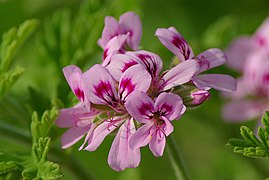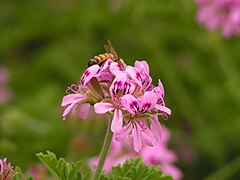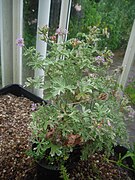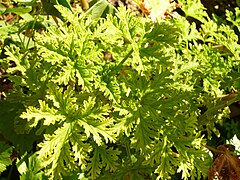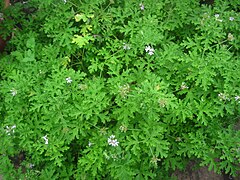
A rose is either a woody perennial flowering plant of the genus Rosa, in the family Rosaceae, or the flower it bears. There are over three hundred species and tens of thousands of cultivars. They form a group of plants that can be erect shrubs, climbing, or trailing, with stems that are often armed with sharp prickles. Their flowers vary in size and shape and are usually large and showy, in colours ranging from white through yellows and reds. Most species are native to Asia, with smaller numbers native to Europe, North America, and northwestern Africa. Species, cultivars and hybrids are all widely grown for their beauty and often are fragrant. Roses have acquired cultural significance in many societies. Rose plants range in size from compact, miniature roses, to climbers that can reach seven meters in height. Different species hybridize easily, and this has been used in the development of the wide range of garden roses.

Geranium is a genus of 422 species of annual, biennial, and perennial plants that are commonly known as geraniums or cranesbills. They are found throughout the temperate regions of the world and the mountains of the tropics, with the greatest diversity in the eastern part of the Mediterranean region.

Pelargonium is a genus of flowering plants that includes about 280 species of perennials, succulents, and shrubs, commonly called geraniums, pelargoniums, or storksbills. Geranium is also the botanical name and common name of a separate genus of related plants, also known as cranesbills. Both genera belong to the family Geraniaceae. Carl Linnaeus originally included all the species in one genus, Geranium, and they were later separated into two genera by Charles Louis L'Héritier de Brutelle in 1789.

Basil, also called great basil, is a culinary herb of the family Lamiaceae (mints). It is a tender plant, and is used in cuisines worldwide. In Western cuisine, the generic term "basil" refers to the variety also known as sweet basil or Genovese basil. Basil is native to tropical regions from Central Africa to Southeast Asia. In temperate climates basil is treated as an annual plant, however, basil can be grown as a short-lived perennial or biennial in warmer horticultural zones with tropical or Mediterranean climates.

Mentha aquatica is a perennial flowering plant in the mint family Lamiaceae. It grows in moist places and is native to much of Europe, northwest Africa and southwest Asia.

Potpourri is a mixture of dried, naturally fragrant plant materials used to provide a gentle natural scent, commonly in residential settings. It is often placed in a decorative bowl.

Pelargonium radens, the rasp-leaf pelargonium is a species of Pelargonium. It is in the subgenus Pelargonium along with Pelargonium crispum and Pelargonium tomentosum.

Pelargonium 'citrosum' is a perennial subshrub with fragrant leaves that are reminiscent of citronella.

Geranium macrorrhizum is a species of hardy flowering herbaceous perennial plant in the genus Geranium, family Geraniaceae. It is native to the South east Alps and the Balkans. Its common names include bigroot geranium, Bulgarian geranium, and rock crane's-bill.
Geranium is a genus of 422 hardy flowering plant species.
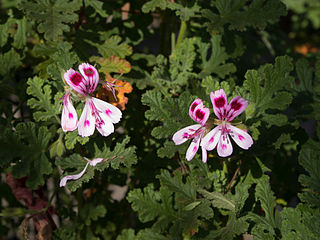
Pelargonium quercifolium is a species of geranium known by the common name oakleaf geranium or oak-geranium. It is native to South Africa, and it is a commonly grown ornamental plant. It is in the subgenus pelargonium along with Pelargonium crispum and Pelargonium tomentosum.

Pelargonium capitatum is one of several species known as rose geranium or rose-scented pelargonium in English. The popular names refer to the scent of the essential oils extracted from glandular tissue, not the flowers, which have hardly any scent to speak of. Some of the species are known as kusmalva in Afrikaans.

Pelargonium × hortorum, commonly called zonal geranium, or garden geranium, is a nothospecies of Pelargonium most commonly used as an ornamental plant. It is a hybrid between Pelargonium zonale and Pelargonium inquinans. They are the group of Pelargonium cultivars, with leaves marked with a brown annular zone and inflorescence in the form of large balls of tight flowers, usually red, pink, or white. These are the most common geraniums of garden centers and florists, sold in pots for windowsills and balconies or planted in flowerbeds.

Pelargonium zonale is a species of Pelargonium native to southern Africa in the western regions of the Cape Provinces, in the geranium family. It is one of the parents of the widely cultivated plant Pelargonium × hortorum, often called "geranium", "horseshoe geranium", "zonal geranium" or "zonal pelargonium".

Pelargonium crispum is a Pelargonium species native to the Western Cape Province, South Africa. It is in the subgenus Pelargonium along with Pelargonium graveolens and Pelargonium capitatum and Pelargonium tomentosum.
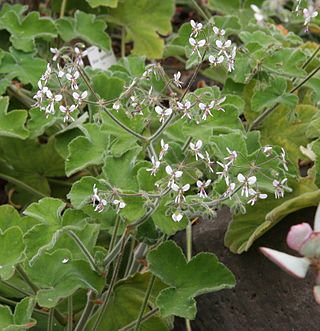
Pelargonium tomentosum, the peppermint-scented geranium, is a pelargonium species native to South Africa. It is in the subgenus Pelargonium along with Pelargonium graveolens, Pelargonium crispum and Pelargonium capitatum.
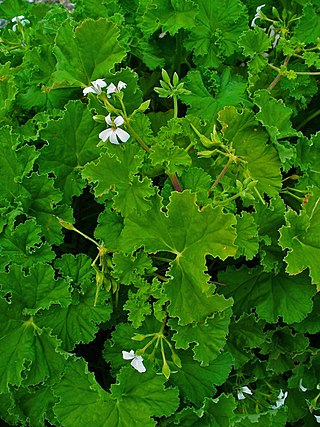
Pelargonium odoratissimum is a pelargonium species native to South Africa. It is also known as the apple geranium or apple pelargonium due to the distinct apple scent. It is in the subgenus Reniforme along with Pelargonium sidoides and Pelargonium exstipulatum.
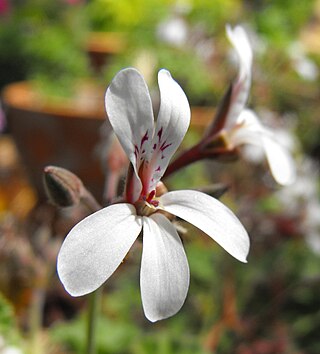
Pelargonium × fragrans is a pelargonium hybrid between Pelargonium odoratissimum and Pelargonium exstipulatum. It is in the subgenus Reniforme along with Pelargonium sidoides and Pelargonium abrotanifolium.

Pelargonium exstipulatum is a pelargonium species native to South Africa. It is in the subgenus Reniforme along with Pelargonium odoratissimum and Pelargonium sidoides.

Pelargonium cordifolium is a plant endemic to the fynbos region of the Southern Cape of South Africa.


